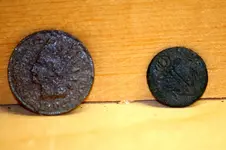That what I thought you would say, so analysing the below, what is the conclusion?
'I have looked at the (not very good) image of your naval button again and have just noticed that that the anchor is not 'fouled'. This feature for the most part eliminates the Royal Navy. There is the odd instance the first Surgeons at Sea official issue shows an anchor without the rope, Secretary to the Commander-in-Chief the same (although with a crown above the anchor). THEREFORE the pattern that you illustrate with the design INCISED is more than likely to apply to a Continental navy and no doubt used by the lower ranks of some of the Mercantile Marine Companies' personnel.
Certainly early Royal French naval personnel c1770-1790 used a similar button.
As I mentioned earlier this pattern both incised and in relief was used on ladies and childrens' fashion clothing in the 19th and early 20th centuries.
Printed works on the subject are very few and scarce. The two best Royal Naval articles are those of the late Captain A Rowand DSO (Connoisseur Magazine 1927 under the heading 'Miscellaneous' Some Early English Sea Service Buttons). Then 'Naval Buttons' by Michael Lewis, 'The Mariner's Mirror' Volume 31 No3 1945. This is extensive and quite excellent. It was based on Rowand's collection and corrected some of Rowands attributions. However Lewis failed to recognise the importance of back marks as a guide to dating, so again there are some incorrect attributions. A much later article by one Barker (Greenwich) is hopeless and indeed useless.
Various other contibutions on Mercantile buttons and other Navies have appeared in Button Lines (mag of the British Button Society) over the years but that is about the lot.
There is and always will be confusion over the plain anchor button, as it was and still is such a universal theme, as indeed you remark upon.'




 I think French Navy was mentioned (along with others), does that fit your references? (I thought you may have already said by now though??)
I think French Navy was mentioned (along with others), does that fit your references? (I thought you may have already said by now though??)



